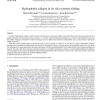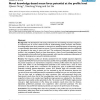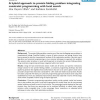59 search results - page 7 / 12 » The Small-World Model for Amino Acid Interaction Networks |
CANDC
2006
ACM
13 years 7 months ago
2006
ACM
A model of hydrophobic collapse, which is treated as the driving force for protein folding, is presented. This model is the superposition of three models commonly used in protein ...
BMCBI
2008
13 years 7 months ago
2008
Background: Amino acid sequence probability distributions, or profiles, have been used successfully to predict secondary structure and local structure in proteins. Profile models ...
NAR
2006
13 years 7 months ago
2006
The Simple Modular Architecture Research Tool 10 (SMART) is an online resource (http://smart.embl. de/) used for protein domain identification and the analysis of protein domain a...
BMCBI
2006
13 years 7 months ago
2006
Background: The development and testing of functions for the modeling of protein energetics is an important part of current research aimed at understanding protein structure and f...
BMCBI
2010
13 years 7 months ago
2010
Background: The protein folding problem remains one of the most challenging open problems in computational biology. Simplified models in terms of lattice structure and energy func...



